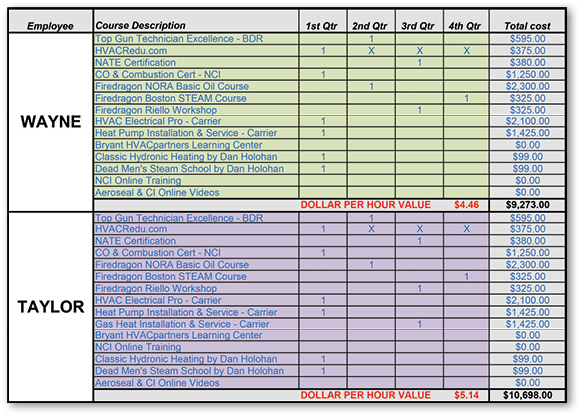Creating the Plan
When it’s time to put an actual annual plan together, I look at how training went the previous year, what the current needs are for the entire team, and consider the input from my managers. Then I create an outline that I have to revisit and fill in once outside training schedules are published and available.
Plus, I’m always on the lookout for last-minute training that might come up as well as programs that provide our technicians certification and certification renewals.
We start with general needs such as customer service rep, technician, and sales training, then break that down to individual employees. Then we focus on the employees who really want to go above and beyond on their own.
We set the initial plan at a higher level ‘ a 30,000-ft. view. This helps us sketch out the more costly and necessary training and/or most needed training for budgeting purposes.
Then we look at the industry calendars of all the HVAC training organizations – National Comfort Institute, Air Conditioning Contractors of America, and most of the others ‘ to match what they are offering to our technicians’ needs.
Other Considerations

Of course, many things play into our ability to plan out an annual strategy. Obviously, if the training we need isn’t available, we have to postpone until it is. Other factors include employee turnover, conflicts of the outside training organizations, busy times, whether our techs are taking advantage of available online training programs we provide, and more.
We also consider the needs of new hires and the initial training they may need. Over the years, we have become wiser when it comes to training new hires ‘ we’ve been burned too many times. So, we invest in their training, but don’t invest too heavily until they prove themselves.
Our high-level schedule is a guideline. My rule-of-thumb on creating a training plan is to think of it as a living document ‘ it must be as flexible as possible. Our plan is annual, but I revisit it monthly and modify it as necessary throughout the year.
Then we share the final draft of our training plan with the training manager, Paul Lizotte. Each month, Paul and I will discuss who (on the technical side) needs what training as well as what local training comes up from vendors that we feel are important to attend.
Online Training
One of the smartest things I did was invest in an online training program that allows our technicians to take classes on their own schedule and at their own pace. There are a number of resources out there that look very expensive on paper, but I’ve found they are relatively inexpensive if you make full use of them.
One thing that separates our company from the competition is our five-tier technician career path. Each tier has a number of goals and accomplishments that must be completed to advance to the next tier. Each tier has it’s own pay range, so the technicians have a lot of control over how quickly they advance and how much they can earn.
Completing online training is key for each technician career tier.
Furthermore, online training is completely in our control. We don’t have to wait on schedules or worry about class cancellations. It is always there. We combine online and live training requirements for each of our five technician career tiers.
As I see it, one fundamental problem in this industry is most technicians need training, but because they are bad planners, they never seem to have the money for it. Because they don’t seem to have the money, they won’t do it on their own. They expect their employers or their vendors to provide and pay for it.
There comes a point where I say that ‘Big Daddy’ isn’t going to do everything with regard to training. So, as a company, unless we commit to it, and your people commit to it, they will be stuck where they are for a lifetime. I like to see a technician commit to getting the training done. That shows me a lot.
Online training and webinars are great tools to help techs improve their skills and learning, as well as a great way for us to monitor their commitment and progress.
Click below for next page













Recent Comments